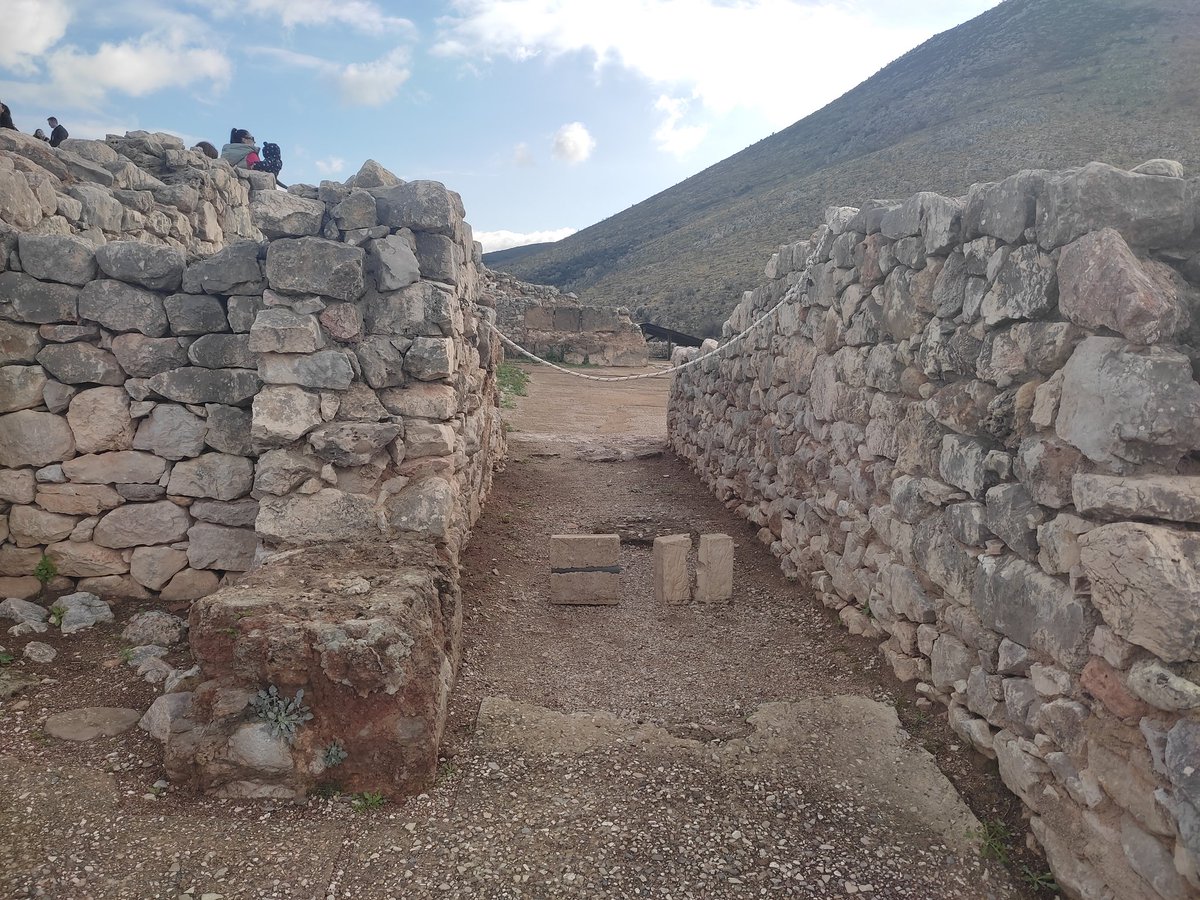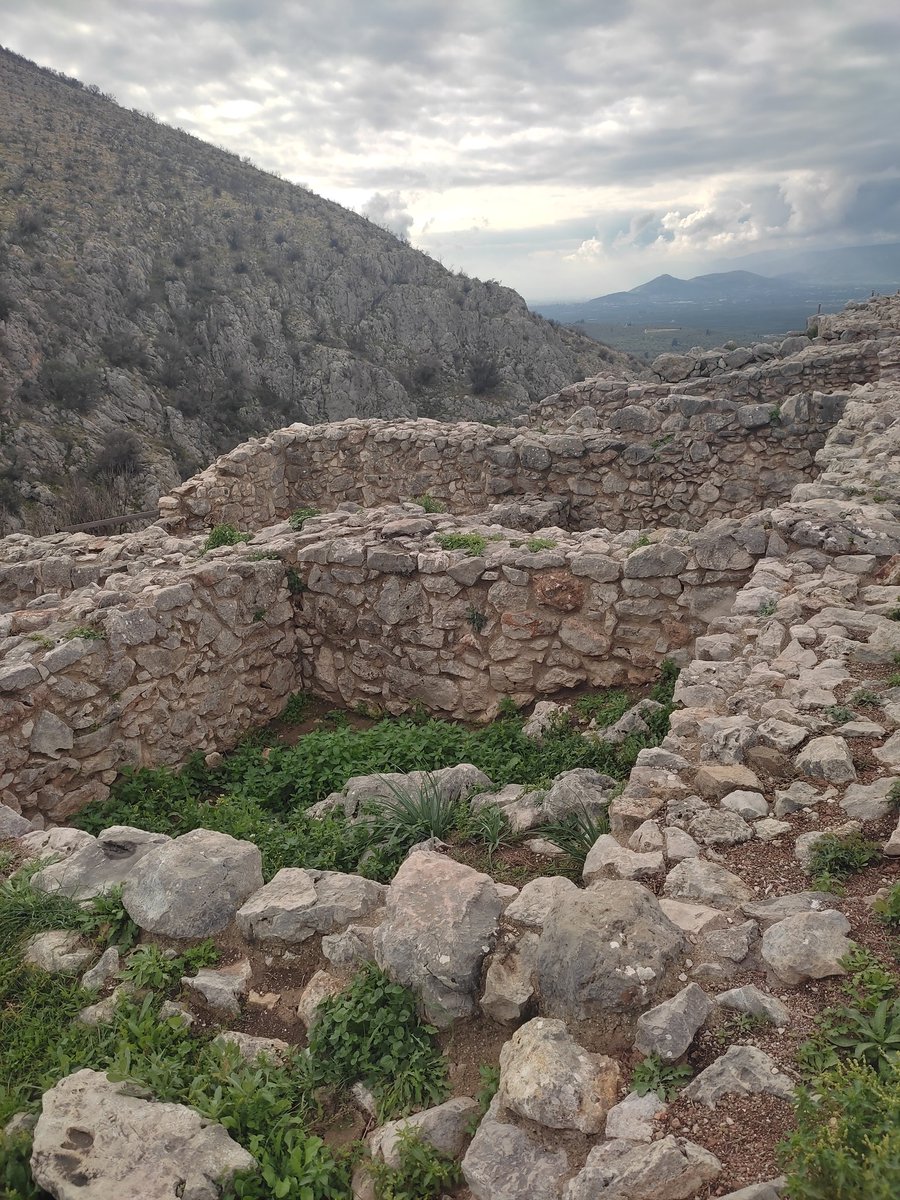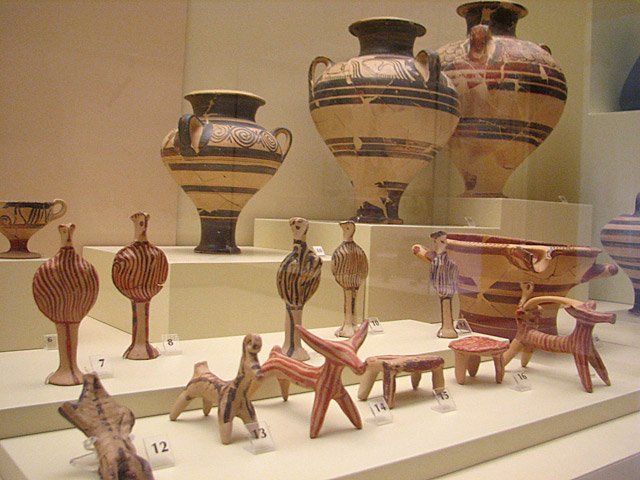
1/ #Sunday excursion to the archaeological site of #Mycenae, at the center of the first Greek-speaking civilization. Sunny morning, ideal for a walk in a sacred ancestral place of which the magnificence of monuments inspires awe even today. 

2/Upon entering the site, on the right stands the Grave Circle B, a burial complex of 26 unplundered shaft and cist graves, in which the members of the founding dynasty of Mycenae were buried. They are dated between 1675/1650-1550 BC with the earliest graves bearing poor grave ➡️ 

➡️ goods and dating back to the Middle Helladic III phase, a period in which certain local elites of mainland are timidly attempting to rise within their communities through the acquisition of agropastoral surpluses and their attempt to participate in the Aegean trade networks. 

3/ However, over time the members of the Mycenaean founding elite became more intensively involved in the long-distance trade routes resulting in the display of their superiority through the deposit of rich grave goods, the majority of which were elaborate ➡️ 

➡️ and exotic imported objects. The buried of Grave Cycle B' were skilled warriors (numerous sets of weapons), whose main occupation was hunting (hunting tents on burial steles). 

4/ Modern studies have shown that several members of those buried in Grave Circle B had very close affinity to each other, indicating a family sequence of succession, while both the male members of the dynasty, as well as the females, had congenital rights in the power sharing. 

5/ Proceeding towards the Citadel we reach the imposing Lion Gate, the main entrance to the Citadel of Mycenae, which received its name from the relief sculpture ➡️ 

➡️ depicting two lionesses facing each other, posing in a heraldic attitude on an altar on which is placed a conical column of Minoan type. 

6/ The relief sculpture stands above the lintel of the central gate and dates to the middle of the 13th century BC, a period during which the second fortification expansion of Mycenae took place. ➡️ 

➡️The Lion Gate was the most important element of this expansion, while at the same time the construction of a rectangular rampart on its western side,as well as the configuration of around fortification,indicates defensive constructions to defend the central gate of the Citadel. 

7/ At the end of the LH IIIB1 phase in Mycenae, several buildings outside the walls of the Citadel suffered serious damage due to fire as a result of an earthquake or human action. ➡️ 

➡️ Immediately afterwards the Mycenaean ruling class proceeded to build large defensive works, probably fearing a potential enemy attack. 

8/ But there is another explanation. The new fortification expansion with its imposing cyclopean walls was an element of projecting the power of the Mycenaean elite both to its subjects and to anyone else willing to challenge its rule. ➡️ 

➡️ The Lion Gate is the sealing of worldly, but also divine sovereignty (lions attend in Minoan depictions of religious character), an obvious labelling after the destruction. 

9/ Passing the Lion Gate we see in front of us the Great Ramp that leads to the palace and on the right the Grave Circle A, a burial complex consisting of six shaft graves, ➡️ 

➡️ each of which was covered by a mound, while burial steles were erected to commemorate the powerful members of the Mycenaean ruling class who were buried there. 

10/ The beginning of the burials dates back to around 1600 BC, that is, for some time it was in use at the same time as the late burials of the Grave Cycle B, while it lasted for almost a century. ➡️ 

➡️ The rich and special grave goods demonstrate that the buried are members of the ruling elite, who were warlike, charioteers, hunting enthusiasts, had great wealth and actively participated in the international trade exchange networks of the time. 

11/ At the dawn of the 15th century BC the Mycenaean lords abandoned burial in shaft graves, turning to the construction of monumental tholos tombs. In the second expansion of the Citadel fortification (<1250 BC), ➡️ 

➡️ the Grave Circle A' was included within the new wall and a double-ring burial precinct was built around it, being turned into a ritual monument in an attempt by the ruling elite of the time to appropriate the heroic past of the buried. 



12/ Next to the Grave Circle A is the House of the Warrior Vase, where the famous early LH IIIC krater was found with the depictions of fully equipped Mycenaean soldiers during their departure to fight and when they are lined up for battle. 

13/ The House of the Warrior Vase together with other buildings located near it, such as the Ramp House, the Southern House and the Citadel House housed important palatial officials. ➡️ 

➡️ Next and along the southern wall follows the Cult Center of Mycenae, where it includes a series of buildings with a strong religious character, such as the House with the Idols, the House of the Fresco, the Tsountas House and the Chief Priest's House. 

14/ The Cult Center of Mycenae was connecting to the Palace through a stairwell and a large processional uphill road. ➡️ 

➡️ Finds from the various buildings related with the Cult Center of Mycenae suggest a cultic activity associated with chthonic male and female deities to whom special ceremonies and animal sacrifices were performed. 



15/ Following the Great Ramp we reach the Palace located at the highest point of the Citadel. It was built around 1350 BC, surrounded by a fortified enclosure. The official entrance to the Palace was through the H-shaped propylon, which has parallels in Tiryns and Pylos. 

16/ Although the location of the Palace has suffered considerable damage, both from soil erosion and from the existence of a classical temple dedicated to Athena or Hera, we can say that the palatial building complex included ➡️ 

➡️ the megaron with the hall of throne where the walls were decorated with exquisite frescoes, the vestibule, the stone altar together with a libation basin, the central hearth, the forecourt. There was a series of rooms that served the needs of the royal couple, ➡️ 

➡️ the hosting of important foreign guests and the offices of the court officials, while there must also have been a small outpost that housed his personal guard of the wanax. 

17/ Continuing we reach the Artists Quarters, the heart of palatial production, where skilled artisans made beautiful household and storage vessels, elaborate gold and silver jewelry, deadly bronze weapons for the palace arsenal, contributing to the prosperity of the kingdom. 



18/ After the Artists Quarters we reach the north-eastern end of the Citadel, where the third phase of the fortification expansion took place at the end of LH IIIB2. ➡️ 

➡️ During this particular period, Mycenae, like the entire Mycenaean mainland, was in a state of intense insecurity, with the consequence that the ruling elite of Mycenae took extraordinary measures to face with a potential siege. 

19/ So they created an underground cirsten which was fed through a tunnel with running water from a spring on Mount Prophet Elias. At the same time they created a Sally Port so they could slip in and out of the Citadel without being detected by enemy scouts. 







20/We don't know to what extent these two preventive measures helped the defenders of Mycenae.What is certain is that at some point during the transition from final LHIIIB2 to early LHIIIC the Citadel fell and the destruction was very violent especially in the area of the Palace. 

21/ A short distance to the west is the North Gate, which has a similar construction and layout to the Lion Gate, but is smaller in size and doesn't bear relief sculpture. It led to buildings to the NW and continuing it was joining with the road that led to the Lion Gate. 



22/ Returning again outside the walls and heading south we encountered two wonderful tholos tombs: of Aegisthus and of Clytemnestra. ➡️ 



➡️ The Tomb of Aegisthus, which is smaller than the Tomb of Clytemnestra, was built in two phases during the 15th century BC and has a relieving triangle above the entrance lintel, while its tholos has collapsed. 







23/ The nearby Tomb of Clytemnestra, dating from around 1250 BC, is the last tholos tomb of Mycenae and is one of the most representative examples of Mycenaean tholos tombs. I was particularly impressed by the harmonious welding of the stones on the ceiling of the burial chamber. 





24/ To the south of the two tholos tombs are the ruins of four buildings, which are known as the House of the Shields, the House of Oil Merchant, the House of the Sphinxes and the Western House. The most important of these seems to have been the House of Oil Merchant, ➡️ 

➡️ which housed a workshop for the production of aromatic and essential oils, products that decisively supported the international trade of the Mycenaeans, as evidenced by the presence of inscribed Linear B' tablets found in this building. 

25/ In conclusion,I'd like to emphasize that it is necessary to combine the visit to the archaeological site of Mycenae with a visit to the local museum, where there are beautiful examples of ceramics,frescoes,figurines,weapons (especially bronze swords),jewelry and golden masks 

• • •
Missing some Tweet in this thread? You can try to
force a refresh



















